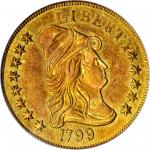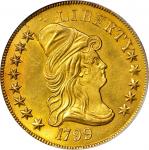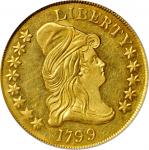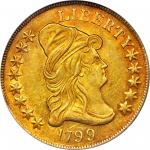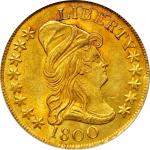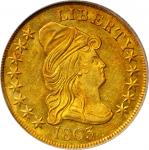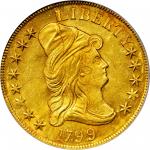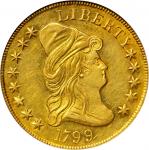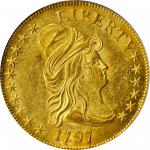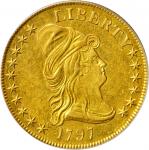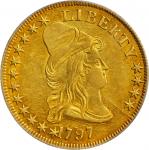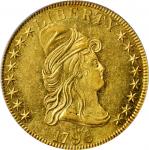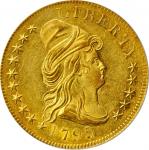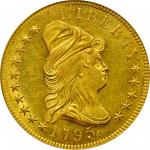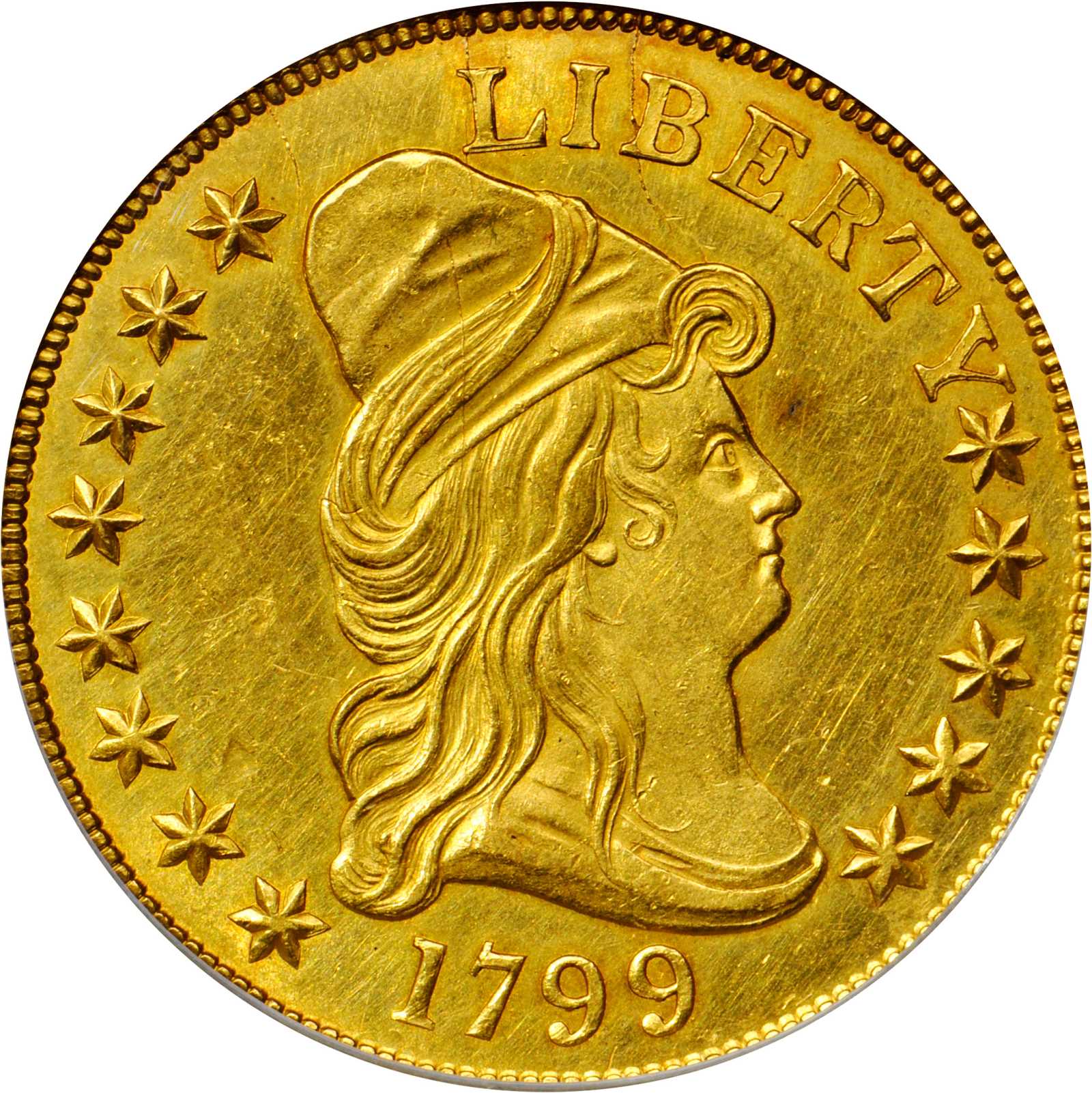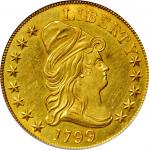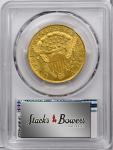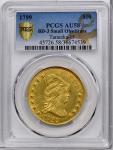1799 Capped Bust Right Eagle. BD-3, Taraszka-15. Rarity-6+. Small Obverse Stars. AU-58 (PCGS).Type and Style: Type II: Capped Bust Right, Heraldic Eagle. Style VI: Head of 1795 with 13 small stars arranged eight left, five right; Reverse of 1799 with 13 small stars in the field below the clouds and a short, thick neck on the eagle. The head and eagle punches are attributed to hubs prepared by Robert Scot.Die Variety: BD-3, Taraszka-15, Breen 1-A, HBCC-3184. This variety represents the only use of this obverse die in the Capped Bust Right eagle series and the third of four uses of this reverse die. On the obverse, the date is wide with even spacing between the digits. Star 9 is close to, but does not touch the letter Y in LIBERTY, and star 13 is also close to the end of Libertys bust. Star 1 presents two points to the lowermost hair curl, and close inspection with a loupe reveals a tiny die rust lump in the field to the right of the midpoint of the letter R in LIBERTY. On the reverse, the lowermost arrow head is under the extreme left edge of the letter N in UNITED, a leaf tip just touches the center of the letter I in UNITED, the lowermost berry is centered under the final letter A in AMERICA, and there are small die rust lumps between the letters UN in UNITED and within the top of the N. The faint, jagged die line that usually bisects the letter O in OF on coins struck from this reverse die is no longer present on this coin due to the late die state (see below).Die State: BD Die State c/d-e. This is the latest known die state of this variety. The obverse exhibits three prominent cracks: from the border outside the letters IB in LIBERTY, through the lower left corner of the B and jaggedly through the field and the forehead curl; from the upper border along the left side of the letter L in LIBERTY, intermittently through the cap and into the middle hair curls at the back of the head; from the border past star 8, curving into the field area between that star and the back of the cap. The reverse exhibits the same cracks as seen on the 1799 BD-2 example in Die State d/c-d offered above, although the crack through the tops of the letters MER in AMERICA is now a bit bolder. Light lapping of the die has removed the faint die line through the letter O in OF and the crack from the border to the second feather from the top of the eagles left wing tip, confirming that the reverse die had advanced fully from State c to State d at the time this coin was struck. This coin represents an intermediate reverse die state with additional faint cracks not reported by Dannreuther for the 1799 BD-3 pairing: from the border to the upper right corner of the letter U in UNITED; from the border to the top of the final letter A in AMERICA; and from the border through the letter I to the letter C in the same word. These cracks are bolder and more pronounced on the 1799 BD-4 eagle offered below, which we believe represents the full Die State e for this reverse.Estimated Mintage for the Issue: The conventionally accepted mintage has been 37,449 coins for the 1799 Capped Bust Right eagle issue, based on Walter Breens assumption that all of the coins delivered between May 14, 1799, and September 4, 1800, were from 1799-dated dies. After careful study, Dannreuther provides a revised range of 31,750 to 46,250 pieces produced, the lower estimate allowing for the possibility that some 1797 BD-3 and/or BD-4 coins were included in Breens 37,499-piece mintage, and the upper estimate allowing for the possibility that some 1799-dated eagles were also included in later deliveries.Estimated Mintage for the Variety: Dannreuther estimates that 1,000 to 1,500 examples were coined from the 1799 BD-3 dies.Estimated Surviving Population for the Variety: Only 16 to 20 coins are believed extant in all grades (per Dannreuther).Strike: With virtually all design elements sharply to fully defined, this is an exceptionally well preserved early eagle that is nearly in the Mint State category.Surfaces: Both sides exhibit medium gold patina with splashes of pale pinkish-rose in isolated peripheral areas. Wispy hairlines and a somewhat glossy texture are noted for the obverse, although there is little in the way of wear and much of the original satin to modestly semi-prooflike finish can be seen under a light. The reverse is essentially Mint State with full satin to modestly semi-prooflike luster and only a few wispy handling marks. The only provenance marker of note is a small, shallow planchet void in the obverse field at star 2.Commentary: The Mint continued to have difficulty with early die breakage in its striking of 1799-dated eagles. The obverse of the BD-3 pairing, like those of the 1799 BD-1 and BD-2 varieties, was withdrawn from production after relatively few coins were struck. It is little wonder, therefore, that survivors from the 1799 BD-3 die marriage are highly elusive in todays market.This is an upper end example for the assigned grade that, with no discernible wear and nearly full luster, is virtually in the Mint State category. It is a find for both high grade type collectors and advanced early gold variety enthusiasts. This coin is included in the list of Significant Specimens for the variety in the Taraszka early eagle reference, where it is ranked #1.From the Anthony J. Taraszka Collection. Earlier from our (Stacks) sale of March 1982, lot 1211; our (Stacks) William W. Moore Collection sale, March 1992, lot 2086; Heritages Museum of Connecticut History Sale, June 1995, lot 6897. The plate coin for the die variety in the book United States Ten Dollar Gold Eagles: 1795-1804 by Anthony J. Taraszka.

